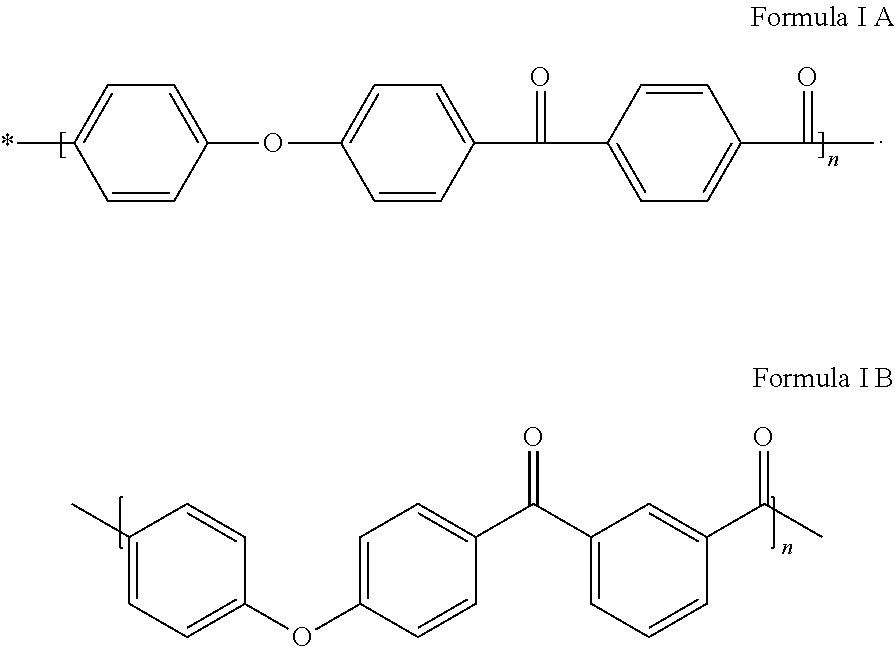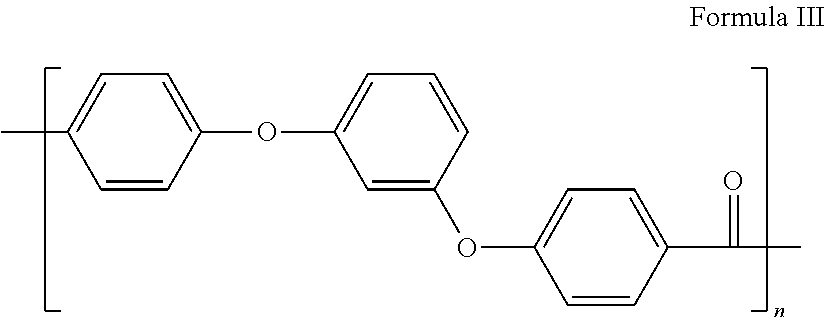Method for impregnating reinforcing fibres with polyaryletherketones and semi-products obtained therefrom
a technology of polyaryletherketone and reinforcing fibers, which is applied in the field of manufacturing of semi-finished products comprising thermoplastic matrix and reinforcing fibers, to achieve the effects of increasing the viscosity, increasing the molecular weight, and increasing the viscosity
- Summary
- Abstract
- Description
- Claims
- Application Information
AI Technical Summary
Benefits of technology
Problems solved by technology
Method used
Image
Examples
examples 1 to 3
Change in the Viscosity According to the Process for the Manufacture of the Semifinished Product
[0116]The impact of the thermal cycle on the change in the viscosity was studied for a PEKK resin (Kepstan 7003, sold by Arkema France) and for semifinished products manufactured from this resin and carbon fibers according to different methods.
[0117]The prepregs were manufactured on the laboratory scale with 70% by weight of Kepstan 7003 resin and 30% by weight of carbon fibers, on the one hand according to a molten route process and, on the other hand, by the dispersion route, according to the following respective protocols:
[0118]1) Method of Impregnation by the Molten Route:
[0119]Approximately 8 g of carbon fiber rovings (12K fiber having an epoxy E13 compatible size sold under the name of HTA40 by Toho-Tenax) are positioned on a polyimide sheet (Upilex film with a thickness of 50μm sold by Ube) using a temperature-resistant aluminum adhesive.
[0120]The carbon fiber rovings are subsequen...
examples 4 to 12
Change in the Viscosity According to the Nature of the Carbon Fibers
[0142]The impact of the thermal cycle on the change in viscosity was studied for samples containing carbon fibers originating from different manufacturers and sized or nonsized. The fibers used here are as follows:[0143]HexTow AS4 fiber, sold by Hexcel (nonsized),[0144]HexTow AS4D fiber, sold by Hexcel (nonsized),[0145]Tenax HTS45 P12 fiber, sold by Toho-Tenax (with thermoplastic compatible size),[0146]Tenax HTA40 E13 fiber, sold by Toho-Tenax (with epoxy compatible size).
[0147]Mixtures of PEKK resin and of these carbon fibers were manufactured according to the following protocol:
[0148]An amount of 2 g of PEKK resin powder (Kepstan 7002, sold by Arkema France, Dv50=20μm) is introduced into a mortar. An amount of 14%, 28% and 43% by weight, with respect to the total weight of the sample, of fibers cut to a length of 0.5 cm is added.
[0149]Mechanical mixing is carried out in the mortar in the presence of a few drops of...
examples 13-21
Evaluation of the Thermal Stability of Surfactants
[0153]The impact of the thermal cycle on the change in the weight-average molecular weight Mw was studied for a PEKK resin (Kepstan 7002, sold by Arkema France) for different surfactants.
[0154]The samples were manufactured according to the following protocol:
[0155]An aqueous surfactant solution is prepared by introduction, into a flask, of 1000 g of water and also of 0.1 g of a surfactant. The aqueous solution is homogenized for 10 minutes using a magnetic stirrer. Subsequently, 10 g of PEKK powder (sold under the name of Kepstan 7002 by Arkema France, Dv50=20μm) are added and the mixture obtained is stirred for 30 minutes using a magnetic stirrer. The water is subsequently evaporated in an oven at 90° C. for 48 h. A homogeneous mixture of PEKK powder additivated with surfactant is thus obtained.
[0156]The different examples are prepared with the surfactants indicated below.[0157]The surfactant Cremophor® A25 (ethoxylated C16-C18 alco...
PUM
| Property | Measurement | Unit |
|---|---|---|
| volume median diameter Dv50 | aaaaa | aaaaa |
| diameter | aaaaa | aaaaa |
| diameter | aaaaa | aaaaa |
Abstract
Description
Claims
Application Information
 Login to View More
Login to View More - R&D
- Intellectual Property
- Life Sciences
- Materials
- Tech Scout
- Unparalleled Data Quality
- Higher Quality Content
- 60% Fewer Hallucinations
Browse by: Latest US Patents, China's latest patents, Technical Efficacy Thesaurus, Application Domain, Technology Topic, Popular Technical Reports.
© 2025 PatSnap. All rights reserved.Legal|Privacy policy|Modern Slavery Act Transparency Statement|Sitemap|About US| Contact US: help@patsnap.com



